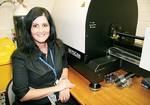Bright light on the cancer horizon
 Health Sciences Health Sciences
One in four people reading this story will die of cancer. It's a statistic that Dr Agatha Labrinidis is reminded of every day as she looks down the barrel of a microscope. But the postdoctoral researcher is hopeful she can help lengthen those odds in a relatively short time. Dr Labrinidis is part of the Bone Cancer Research Group working within the Orthopaedics Department headed by Dr Andreas Evdokiou and Professor David Findlay at the University of Adelaide. Thanks to a recent grant from the Australian Research Council, which has enabled purchase of state-of-the-art equipment for the University's Adelaide Microscopy unit, Dr Labrinidis now has access to Australia's leading technology in this area. The new equipment allows researchers to evaluate new drugs in animal models of cancer. It gives much more information than conventional equipment and also dramatically reduces the number of animals needed for research. Using an In-Vivo Fluorescence/bioluminescence Imaging System and a Live Animal X-Ray Micro Computed Tomography, she is testing new drugs to treat bone cancer, particularly breast and prostate cancers that often metastasize to the bone. "One in eight people in their lives will either be diagnosed with breast cancer or prostate cancer. Once it moves to the bone it is very aggressive and much harder to treat," she said. "Our main aim is to look at new treatments for cancer once it is in the bone because at that stage it causes extreme pain and people are susceptible to fracture as the bone dissolves." Cancer cells are injected into a strain of mice with very low immune systems, and the growth of the tumour is tracked so that researchers can see the beginning of bone loss (osteolysis). New drugs are then trialled on the mice, and their effect on the tumour itself and on the bone destruction is measured. The In-Vivo Imaging System scans mice that have been injected with luminescent-tagged cancer cells. The cells in the bone give off a stronger light as the cancer grows and this also helps researchers to measure tumour growth.
"Again, with treatment, we can see the tumour shrink. The results we are getting with both pieces of equipment are very encouraging," Dr Labrinidis said. "It's the best motivation in the world when you get positive outcomes like this." After graduating from the University of Adelaide with a Bachelor of Science, majoring in Genetics and Biochemistry, Dr Labrinidis completed her Honours at the SA Museum. She then worked for SARDI in the DNA field crop lab before returning to the University to complete her PhD, researching novel therapeutic interventions for osteosarcoma (bone-derived cancer). "I finished my PhD in 2005 and had a couple of job offers in Melbourne. However, I was very keen to stay in Adelaide because I knew this equipment would put us in the forefront of national and international cancer research in this area. It's an opportunity I couldn't pass up." The National Breast Cancer Foundation, the Cancer Council SA and the NHMRC are funding Dr Labrinidis' postdoctoral work under the supervision of Dr Evdokiou. Story by Candy Gibson
|







